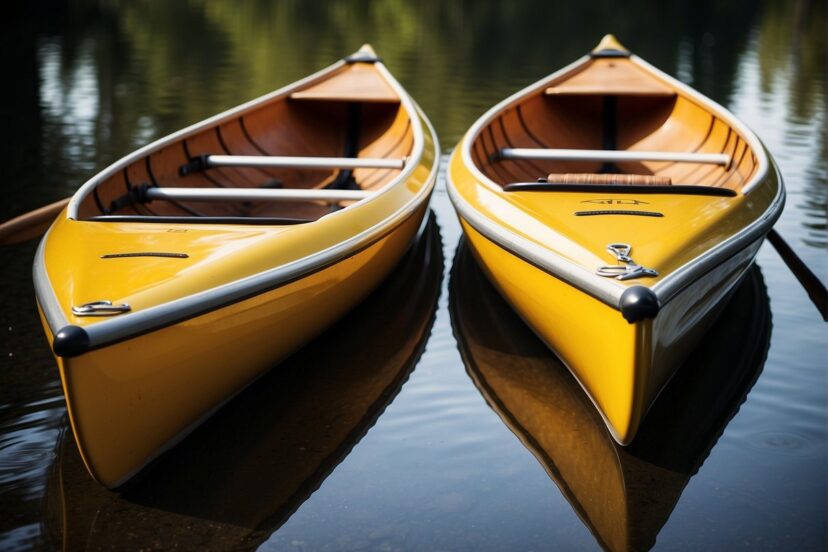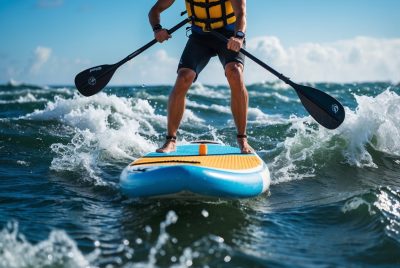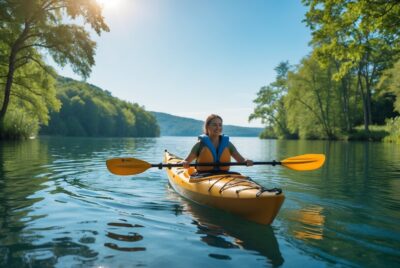Flat Back Canoe Stability: Key Advantages for Calm Waters
*We may earn a commission for purchases made using our links. Please see our disclosure to learn more.
Flat Back Canoe Stability: Key Advantages for Calm Waters
A flat back canoe, often referred to as a square stern canoe, is a versatile watercraft that melds the simplicity of a traditional canoe with the utility of a motorized boat. Unlike the traditional rounded stern of a typical canoe, the squared stern allows for the attachment of a small outboard or trolling motor. This adaptation provides a perfect blend for those who appreciate the quiet glide of paddling but also desire the option of mechanical propulsion for longer distances or against strong currents.

As a seasoned paddler and lover of the outdoors, I’ve found the flat back canoe to be an exceptional choice for a variety of activities, from fishing to hunting, or just recreational enjoyment. The design inherently delivers improved stability which is essential when I am packing gear or facing choppy water conditions. Moreover, the added power option doesn’t only ease navigation but also expands the range of my adventures, assuring that I can explore more secluded spots that were previously out of reach due to physical fatigue or time constraints.
History and Evolution of Flat Back Canoes

In my exploration of watercraft, I’ve found the evolution of canoes fascinating, particularly the development of the flat back or square stern canoe, which blends traditional design with modern adaptability.
Origins of Traditional Canoes
The inception of traditional canoes traces back over 10,000 years. Originating as a vital means of transport for indigenous peoples, these were typically constructed from tree trunks. The method involved hollowing out logs, often a single scotch pine, using simple tools like axes. The oldest known canoe of this kind, the Pesse canoe, exemplifies such early craftsmanship.
Development of the Square Stern Design
In the 1850s, an innovative transformation occurred. Two English woodworkers, inspired by traditional canoe designs, perceived the need for a more efficient construction method, resulting in the birth of the modern hybrid canoe. The defining feature of this era was the square stern design, which catered to mounting an outboard motor. Flat back or square stern canoes are a marriage between traditional canoe design and the utility of a small motorized boat, offering enhanced stability, load-bearing capacity, and the facility for motorized propulsion, a feature cherished by anglers and hunters.
Design and Specifications of a Flat Back Canoe

In this section, I’ll detail the specific design elements and specifications that make flat back canoes unique, focusing on their hull construction, dimensions, capacity, and specialized features for stability and maneuverability.
Hull Design and Materials
Flat back canoes exhibit a distinct square stern design. I can say that this characteristic shape not only sets them apart visually but also serves a practical function: it allows for the attachment of outboard motors. Typically, these canoes are made from materials like aluminum, fiberglass, or T-formex—each offering a balance of durability and weight. For instance, aluminum canoes boast added strength with the incorporation of ribs and features such as a Bulb T keel, which enhance their structural integrity.
Dimensions and Capacity
A crucial aspect in the design of flat back canoes is their length and beam (width). These dimensions directly influence their usability. A common length range for these canoes is between 12 to 16 feet, offering a blend of space and maneuverability. The beam generally measures around 36 inches, providing a stable platform. In terms of weight capacity, some models can carry upwards of 1100 lbs, accommodating gear for activities like fishing or hunting.
Stability and Maneuverability Features
The hull design of a flat back canoe, often a foam core hull, is typically flatter compared to other canoe types, which translates to improved primary stability—that is, stability when the canoe is at rest. In calm conditions, their stability makes them exceptionally reliable, hence their popularity among beginners and families. The flat hull design typically impacts maneuverability, as these canoes may lack the nimble response found in those with a pronounced rocker. Nonetheless, for tracking—maintaining a straight path—flat back canoes exhibit commendable performance, especially when equipped with a motor.
Utility and Versatility

When I consider flat back canoes, I’m drawn to their adaptability for various water activities. They’re particularly favored by outdoorsmen for their capability to be fitted with motors, enhancing their function for both fishing and hunting scenarios, as well as leisure and transportation.
Fishing and Hunting Adaptations
For fishing enthusiasts, flat back canoes like the Old Town Discovery Sport 15 provide ample capacity and stability. They typically come with built-in rod holders, cup holders, and carrying handles which enhance the fishing experience. Anglers appreciate the ability to attach outboard or trolling motors for extended trips, allowing them to cover more ground with less effort. Hunters, especially those engaged in duck hunting, benefit from the silent approach an electric trolling motor allows, keeping the disturbance to a minimum while approaching prey.
For added convenience, some models include oar sockets for easy rowing, and additional mounts to secure gear such as a cooler or extra seats. These adaptations underline their practical nature, which I find invaluable for anyone keen on outdoor pursuits.
Recreational and Transportation Uses
Recreational users find flat back canoes user-friendly, perfect for calm waters or motor-assisted longer distances. The square stern accommodates motors seamlessly, which is convenient for my leisurely tours that could benefit from motorized assistance. This feature is great when transporting goods or people across waterways, turning a simple canoe into a more effective transportation method.
Brands like Sun Dolphin and Grumman have popularized flat back canoes for their ease of use and functional design. They provide a stable platform that is easy to maneuver with paddles or oars, which I find essential for navigating different types of water conditions. The flat back design balances stability and steering, ideal for family outings and beginners.
Accessories and Enhancements

In my experience with flat back canoes, I’ve found that accessorizing for motorization and incorporating various add-ons can significantly enhance the boating experience. Enhancements include motors for power and features for a more enjoyable water trip.
Motorization and Power of a Flat Back Canoe
Motor Size and Type: I recommend a small outboard motor or an electric trolling motor for my flat back canoe to maintain its lightweight advantage. Generally, trolling motors are sufficient for calm waters, but a stronger outboard motor is preferable to navigate strong currents or rough water.
- Outboard Motor: Optimal for power; suits rough conditions.
- Electric Trolling Motors: Best for silent operation; ideal for fishing.
Securing the Motor: My flat back canoe is designed to accommodate a motor, and I find that a secure motor mount is critical for safety and efficiency. The motor’s size should match the canoe’s specifications to avoid imbalance and potential mishaps.
Convenience Features and Add-ons
Rod Holders: These are indispensable for my fishing trips. I ensure that my canoe has several rod holders installed for easy access and tangle-free storage.
- Stationary Rod Holders: for a permanent solution.
- Adjustable Rod Holders: for versatility.
Storage and Comfort: For everyday needs, I equip my canoe with various add-ons. Drink holders and upgraded seating with back support are some key installations that I believe every canoe should have for a more pleasant trip.
- Drink Holders: To keep hydration within arm’s reach.
- Comfortable Seating: Strap-on seat covers; cushioning for extended paddling sessions.
Each of these accessories has substantially improved my time on the water, making it more efficient, comfortable, and enjoyable.
Brand and Model Comparisons of a Flat Back Canoe

Notable Brands and their Offerings
Old Town: Renowned for their quality and durability, Old Town offers models such as the Old Town Discovery Sport 15 Square-Stern Recreational Canoe, which is well-regarded among outdoor enthusiasts for its versatility and suitability for tasks like fishing or duck hunting.
Grumman: A long-standing name in the canoe industry, Grumman’s sturdy aluminum canoes, like the Grumman 19’ Square-Stern, provide proven performance and durability, making it a preferred choice for many paddlers.
Sun Dolphin: The Mackinaw SS Square Stern Canoe is known for its affordability and features such as the bulb T keel for enhanced stability.
Wenonah: They offer a variety of canoes including those made with Tuf-weave Flex-Core or Kevlar Ultra-Light materials, designed for paddlers who demand lightweight yet strong canoes for long-distance trips.
Here is a brief comparison table:
| Brand | Model | Material | Key Feature | MSRP |
| Old Town | Discovery Sport 15 | Three-layer polyethylene | square stern, versatile | Varies |
| Grumman | 19’ Square-Stern | Aluminum | Durable, ideal for motorized use | Varies |
| Sun Dolphin | Mackinaw SS | Polyethylene | Bulb T keel, affordable | Varies |
| Wenonah | Various models (e.g. Flex-Core, Ultra-Light) | Tuf-weave, Kevlar | Lightweight, durable | Varies |
Top Picks for Different Needs
My analysis of best square stern canoes:
- Best for Recreational Use: The Old Town Discovery Sport 15 is a top pick due to its multi-functional design allowing for paddling, fishing, and motorized use.
- Best for Durability: Choosing a Grumman model such as the Grumman 19’ Square-Stern ensures lasting quality and performance, especially for users who favor aluminum canoes.
- Best on a Budget: For those keeping an eye on price, the Sun Dolphin Mackinaw SS has positive reviews for being cost-effective without compromising on essential features.
My focus has been to provide accurate reflections based on MSRP, reviews, and product specifications without any exaggeration. Each brand and model brings unique benefits to the table, catering to various preferences and needs of canoeists.
Frequently Asked Questions
I’ve compiled some of the most commonly asked questions about flat back canoes to help clarify their features and benefits.
1. What is the typical price range for a flat back canoe?
The price for a flat back canoe can vary widely based on size, material, and brand. Usually, these canoes start around $600 and can go up to $2000 or more for high-end models.
2. How does the stability of a flat back canoe compare to other canoe shapes?
A flat back canoe offers exceptional stability due to its wide and flat stern. This design is particularly stable on flat water, making it a preferred choice for fishing and novice paddlers.
3. What are the advantages of adding a motor to a flat back canoe?
Adding a motor to a flat back canoe expands its versatility. It enables longer trips, access to remote fishing spots, and aids paddlers against currents or winds.
4. What should beginners consider when choosing a flat back canoe?
Beginners should consider the canoe’s weight, material, and stability. A lightweight and stable canoe is easier to handle and more forgiving for those new to paddling.
5. Where can I find a used square stern canoe for sale?
Find used square stern canoes on online marketplaces, local ads, forums, and select boating shops with pre-owned gear.




